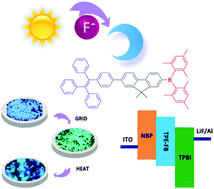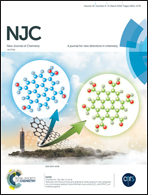A new blue AIEgen based on tetraphenylethene with multiple potential applications in fluorine ion sensors, mechanochromism, and organic light-emitting diodes†
Abstract
In this work, we report a new blue AIEgen, (9,9-dimethyl-7-(4-(1,2,2-triphenylvinyl)phenyl)-9H-fluoren-2-yl)dimesitylborane (TPE-FB), composed of dimesitylboryl, fluorene and tetraphenylethene (TPE) groups. The thermal stability, electronic structure, optical properties, transient fluorescence decay and electroluminescence of TPE-FB are studied. TPE-FB shows high thermal stability and good aggregation-induced emission (AIE) properties. Due to the presence of the dimesitylboryl group, TPE-FB can interact with fluorine ions to cause a blue-shift in the absorption spectrum and an apparent decrease in the emission spectrum. TPE-FB also exhibits mechanochromic properties, and the fluorescence color of its solid can be reversibly switched between blue and sky-blue by simple grinding and heating (fuming). TPE-FB can function as a light-emitting layer in nondoped sky-blue OLEDs with good performances.



 Please wait while we load your content...
Please wait while we load your content...